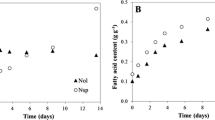Abstract
The cyanobacteriumSpirulina platensis is one of the most promising sources of the polyunsaturated fatty acid γ-linolenic acid (GLA). The GLA content ofSpirulina can be enhanced by cultivation under light-dark cycles in the laboratory or outdoors. Thus, in strain BP, the GLA content increased from 1.2 to 1.6% when cultivated under light-dark cycles. Moreover, in the derived mutant Z19, the GLA content reached 2.4% when cultivated outdoors. To the best of our knowledge, this is the highest GLA content ever reported for any alga.
Similar content being viewed by others
References
Biagi PL, Bordoni A, Masi M, Ricci G, Fanelli C, Patrizi A, Ceccolini E (1988) Evening primrose oil (Efamol) in the treatment of children with atopic eczema. Drugs exptl Clin. Res. 14: 291–297.
Bligh EG, Dyer WJ (1959) A rapid method for total lipid extraction and purification. Can. J. Biochem. Physiol. 37: 911–917.
Ciferri O (1983)Spirulina, the edible microorganism. Microbiol. Rev. 47: 551–578.
Cohen Z, Vonshak A, Richmond A (1987) Fatty acid composition ofSpirulina strains grown under various environmental conditions. Phytochem. 26: 2255–2258.
Cohen Z, Cohen S (1991) Preparation of eicosapentaenoic acid concentrate fromPorphyridium cruentum. J. Am. Oil Chem. Soc. 68: 16–19.
Cohen Z, Didi S, Heimer YM (1992) Over-production of γ-linolenic and eicosapentaenoic acids by algae. Plant Phys. 98: 569–572.
Cohen Z, Reungjitchachawali M, Siangdung W, Tanticharoen M (1993a) Production and partial purification of γ-linolenic acid and some pigments fromSpirulina platensis. J. appl. Phyc. 5: 109–115.
Cohen Z, Norman NH, Heimer YM (1993b) Evaluating the potential of substituted pyridazinones for inducing polyunsaturated fatty acid overproduction in algae. Phytochem. 32: 259–264.
Cohen Z, Reungjitchachawali M, Siangdung W, Tanticharoen M, Heimer YM (1993c) Herbicide resistant lines of microalgae: Growth and fatty acid composition. Phytochem. 34: 973–978.
Hirano M, Mori H, Miura Y, Matsunaga N, Nakamura N, Matsunaga T (1990) γ-linolenic acid production by microalgae. Appl. Biochem. Biotechnol. 24: 183–191.
Horrobin DF (1983) The role of essential fatty acids and prostaglandins in the premenstrual syndrome. J. Reprod. Med. 28: 465–468.
Hudson BJF, Karis IG (1974) The lipids of the algaSpirulina. J. Sci. Food Agric. 25: 759–763.
Ishikawa T, Fujiyama Y, Igarashi C, Morino M, Fada N, Kagami A, Sakamoto T, Nagano M, Nakamura H (1989) Clinical features of familial hypercholesterolemia. Atherosclerosis 75: 95–103.
Kenyon CN, Stanier RY (1970) Possible evolutionary significance of polyunsaturated fatty acids in blue-green algae. Nature 227: 1164–1166.
Mori T, Muranaka T, Miki W, Yamaguchi K, Konosu S, Watanabe T (1987) Pigmentation of cultured sweet smelt fed diets supplemented with a blue-green algaSpirulina maxima. Nippon Suisan Gakkaishi 53: 433–438.
Murata N, Ishida I (1987) Lipids of blue-green algae (cyanobacteria). In P. Stumpf (ed.), The Biochemistry of Plants, Vol. 9. Academic Press, New York: 315–347
Nakahara T, Yokochi T, Kamisaka Y, Suzuki O (1992) Gamma linolenic acid from genusMortierella. In Kyle DJ, Ratledge C (eds), Industrial Application of Single Cell Oil. American Oil Chemists' Society, Champaign), IL; 61–97.
Nichols BW, Wood BJB (1968) The occurrence and biosynthesis of γ-linolenic acid in a blue-green alga,Spirulina platensis. Lipids 3: 46–50.
Roughan PG (1989)Spirulina: a source of dietary gamma-linolenic acid? J. Sci. Food Agric. 47: 85–93.
Suzuki O, Toshihiro Y (1985) Microbial production of γ-linolenic acid-rich phosphatidyl choline. Jpn Kokai Tokkyo Koho JP 62 25, 989
Sukenik A, Carmeli Y (1990) Lipid synthesis and fatty acid composition inNannochloropsis sp. (Eustimatophyceae) grown in a light-dark cycle. J. Phycol. 26: 463–469.
Tanticharoen M, Bunnag B, Vonshak A. (1993) Cultivation ofSpirulina using secondary treated starch wastewater. Australian Biotechnology 3: 223–336.
Vonshak A (1986) Laboratory techniques for the cultivation of microalgae. In Richmond A (ed.), Handbook of Microalgal Mass Culture. CRC Press, Boca Raton, FL: 117–145.
Vonshak A (1987) Biological limitations in developing the biotechnology for algal mass cultivation. Sciences de l'Eau 6: 99–103.
Author information
Authors and Affiliations
Additional information
Author for correspondence
Rights and permissions
About this article
Cite this article
Tanticharoen, M., Reungjitchachawali, M., Boonag, B. et al. Optimization of γ-linolenic acid (GLA) production inSpirulina platensis . J Appl Phycol 6, 295–300 (1994). https://doi.org/10.1007/BF02181942
Received:
Revised:
Accepted:
Issue Date:
DOI: https://doi.org/10.1007/BF02181942




